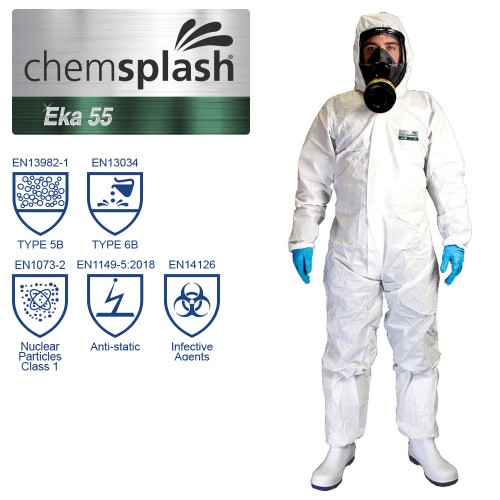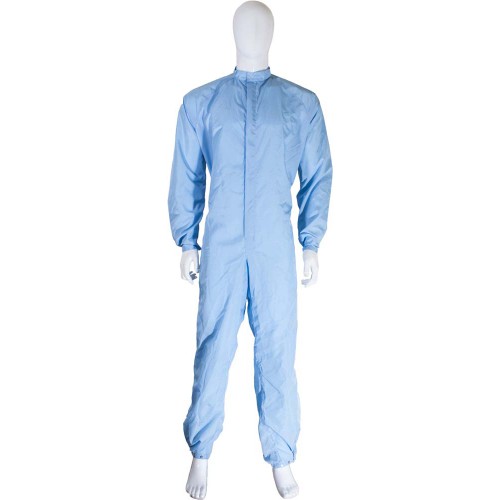Disposable vs Reusable Coveralls: Which is Right for You

In many industries, the importance of protective clothing cannot be overstated. Whether working in hazardous environments or dealing with contamination risks, having the right personal protective equipment (PPE) is essential for safeguarding workers' health and ensuring compliance with safety regulations. Protective coveralls, in particular, play a crucial role in shielding workers from harmful particles, chemicals, and other environmental hazards.
When it comes to choosing coveralls, the two main options are disposable and reusable. Both have their advantages and drawbacks, depending on the work environment and the specific needs of the task. Disposable coveralls, such as Type 5/6, offer convenience and contamination control, while reusable coveralls provide durability and long-term cost savings.
This blog will compare the key features and benefits of disposable and reusable coveralls, helping you to determine which type is best suited for your workplace. Whether your priority is hygiene, cost-efficiency, or environmental impact, this guide will provide valuable insights to help you make an informed decision.
What Are Disposable Coveralls?
Disposable coveralls are single-use protective garments designed to be worn once and discarded after use. They are typically made from lightweight, breathable materials such as non-woven fabrics, offering protection from a range of hazards while maintaining comfort and mobility. These coveralls are often favoured in environments where contamination control is a priority or where the risk of exposure to hazardous substances is significant. The main benefit of disposable coveralls is that they eliminate the need for cleaning and maintenance, reducing the risk of cross-contamination between jobs or tasks.
| Combinaison Chemsplash Eka 55 Type 5B/6B |
 |
A specific type of disposable coverall that stands out is the Type 5/6 coverall, which is designed to offer protection against airborne solid particles (Type 5) and light liquid chemical splashes (Type 6). These coveralls provide a reliable barrier in environments where workers may encounter hazardous dust, fibres, or splashes from non-dangerous chemicals.
Type 5/6 disposable coveralls are essential in industries where there is a need for consistent protection against contamination, particularly in settings where hygiene is critical and disposable PPE is preferred for its simplicity and cost-effectiveness.
- Key Industries Where Disposable Coveralls Are Used:
- Pharmaceuticals: To prevent contamination and protect workers from hazardous dust.
- Healthcare: For use in infectious environments where single-use garments reduce the spread of pathogens.
- Asbestos removal: Protects workers from airborne asbestos fibres.
- Manufacturing and construction: Provides protection from dust and light chemical splashes in various industrial settings.
This versatility makes disposable coveralls, especially Type 5/6, a popular choice across a wide range of sectors.
What Are Reusable Coveralls?
Reusable coveralls are protective garments designed for multiple uses, often made from durable, heavy-duty materials that can withstand repeated wear and cleaning. Unlike disposable coveralls, which are discarded after a single use, reusable coveralls are intended to be worn over long periods and can be laundered and maintained to extend their lifespan. Their durability makes them particularly suited for work environments where protection is needed regularly, but where the risks are lower in terms of contamination or exposure to hazardous substances.
| ZCR167 Cleanroom Coverall Stud Cuff & Ankle |
 |
Reusable coveralls are typically made from materials like cotton blends, polyester, or high-performance fabrics that provide varying levels of resistance to physical wear, chemicals, and heat. These materials are chosen for their strength, flexibility, and ability to be cleaned and sanitised without compromising the protective qualities of the garment.
- Types of Reusable Materials:
- Cotton and cotton blends: Often used in less hazardous environments where breathability and comfort are key.
- Polyester: A durable, easy-to-clean material that offers greater resistance to liquids and chemicals.
- High-performance fabrics: Such as aramid fibres (e.g., Kevlar) or other flame-resistant materials, which are designed for environments with high risks of fire or extreme heat.
Reusable coveralls are well-suited for industries where workers need consistent protection over extended periods and where the risks of contamination or frequent garment changes are lower. The durability of these coveralls means they can provide long-term cost savings, although they require regular cleaning and maintenance to ensure they continue to offer adequate protection.
- Typical Applications and Industries for Reusable Coveralls:
- Oil and gas industry: Where flame-resistant and durable garments are necessary for high-risk environments.
- Construction and heavy industry: Offering protection from physical wear and tear, as well as exposure to dust and light chemicals.
- Automotive and mechanical work: Where long-lasting protection is needed against oils, greases, and dirt.
- Utilities and infrastructure: Durable coveralls are used for tasks involving electrical work or general maintenance.
While reusable coveralls provide durability and cost-efficiency, they require more investment in terms of cleaning and maintenance compared to their disposable counterparts.
Advantages of Disposable Coveralls
Disposable coveralls offer several distinct advantages, particularly in environments where hygiene, contamination control, and ease of use are critical. These benefits make them a preferred choice in various industries where safety, convenience, and efficiency are top priorities.
1. Hygiene and Contamination Control
One of the main advantages of disposable coveralls is their ability to maintain high standards of hygiene. Since they are designed for single use, there is no risk of cross-contamination between tasks or job sites. After each use, the coveralls can be safely discarded, ensuring that no harmful substances or pathogens are transferred from one environment to another. This is particularly important in sectors such as healthcare, pharmaceuticals, and food processing, where maintaining a sterile environment is essential.
2. Cost-Effectiveness in Certain Scenarios
In scenarios where frequent garment changes are required, such as in hazardous or contamination-prone environments, disposable coveralls can be more cost-effective than reusable ones. The initial lower cost of disposable garments, combined with the elimination of laundering or decontamination expenses, makes them an affordable option for industries with high turnover rates of PPE. This is especially beneficial in short-term or high-volume use cases, where the cost of maintaining reusable coveralls might outweigh the savings from reusing them.
3. Ease of Use and Convenience
Disposable coveralls are designed to be lightweight, easy to put on, and comfortable to wear for extended periods. Since they do not require cleaning or maintenance, they provide the ultimate convenience in PPE. Workers can quickly don a fresh pair of coveralls without worrying about cleaning protocols, ensuring they can focus on their tasks without interruption. The convenience of disposable coveralls also extends to their portability and ease of storage, making them ideal for industries where workers need quick access to protective clothing on-site.
These advantages make disposable coveralls a practical and efficient choice, particularly for industries where contamination risks are high, or where the convenience of single-use garments is paramount.
Advantages of Reusable Coveralls
Reusable coveralls offer several key advantages, particularly in industries where long-term use, durability, and environmental considerations are important. While the initial investment in reusable coveralls may be higher, their long-lasting nature and ability to withstand repeated wear make them a valuable option for many work environments.
1. Long-Term Cost Savings
Although the upfront cost of reusable coveralls is typically higher than that of disposable options, their ability to be used repeatedly can result in significant cost savings over time. In industries where workers require protective clothing on a regular basis, reusable coveralls eliminate the need for frequent replacements. By investing in durable garments that last longer, companies can reduce their PPE expenses in the long run. This is particularly beneficial in settings where the level of contamination risk is lower and garments can be safely washed and reused without compromising worker safety.
2. Durability and Suitability for Repeated Use
Reusable coveralls are designed for durability, making them well-suited for environments where heavy-duty protection is needed. Made from strong materials like cotton blends, polyester, or flame-resistant fabrics, they can withstand harsh working conditions, including exposure to chemicals, dirt, and physical abrasion. Their resilience means they are ideal for repeated use, allowing workers to perform demanding tasks without worrying about the integrity of their protective clothing. This durability also makes them more cost-effective in scenarios where protection is needed over an extended period, as they require fewer replacements compared to disposable coveralls.
3. Environmental Considerations
In an era of increasing environmental awareness, reusable coveralls offer a more sustainable option compared to single-use disposable garments. By reducing the frequency of disposal, reusable coveralls help to minimise the amount of waste generated by PPE. They can be laundered and maintained over a long period, reducing the environmental impact associated with producing and disposing of single-use garments. For companies aiming to improve their sustainability efforts, opting for reusable coveralls aligns with eco-friendly practices and reduces the overall environmental footprint of their operations.
These advantages make reusable coveralls an excellent choice for industries where long-term durability, cost savings, and environmental impact are significant factors in PPE selection.
Comparing Disposable and Reusable Coveralls
When deciding between disposable and reusable coveralls, it’s essential to weigh several factors, including initial costs, maintenance, and specific workplace needs. Both types of coveralls offer distinct benefits depending on the environment and the level of protection required, so understanding these key differences will help make an informed decision.
1. Initial Cost vs. Long-Term Investment
- Disposable Coveralls: These typically have a lower upfront cost, making them an attractive option for short-term use or in situations where garments must be changed frequently. This is particularly useful in environments with high contamination risks or where one-time use is required to prevent cross-contamination.
- Reusable Coveralls: While they require a higher initial investment, reusable coveralls pay off over time due to their durability and extended use. For industries that require long-term protection and frequent PPE use, reusable coveralls can lead to significant cost savings by reducing the need for continuous purchasing of new garments.
2. Maintenance and Cleaning Requirements
- Disposable Coveralls: These offer the convenience of single-use wear, eliminating the need for cleaning or decontamination. After use, they are simply discarded, reducing the risk of contamination transfer between tasks or locations. This makes them ideal for situations where hygiene is a top priority.
- Reusable Coveralls: Reusable coveralls require regular laundering and maintenance to ensure they remain effective and safe for repeated use. This can involve both time and financial resources, as companies must either invest in cleaning facilities or outsource the task. Additionally, proper maintenance is crucial to ensure the coveralls continue to meet safety standards over time.
3. Application-Specific Considerations
- Contamination Risk: In industries such as healthcare, pharmaceuticals, or asbestos removal, where contamination risks are high, disposable coveralls are often preferred for their one-time-use nature, which prevents the spread of hazardous materials.
- Hazard Level: In high-risk environments, such as those with exposure to extreme heat, chemicals, or radioactive particles, reusable coveralls made from specialised materials (e.g., flame-resistant fabrics or chemical-resistant fibres) may be more suitable due to their durability and ability to withstand repeated use in harsh conditions.
- Workplace Flexibility: For environments with varied risk levels, companies may opt for a combination of both disposable and reusable coveralls, using disposable garments for high-contamination areas and reusable options for less hazardous tasks.
By considering these factors - cost, maintenance, and application-specific needs - businesses can determine which type of coverall best suits their operational demands, ensuring both protection and efficiency in the workplace.
When Should You Choose Type 5/6 Disposable Coveralls?
Type 5/6 disposable coveralls are specifically designed to provide protection in environments where exposure to hazardous airborne particles and light liquid splashes is a concern. These coveralls offer a combination of protection, convenience, and cost-effectiveness, making them ideal for short-term use in various high-risk situations.
Specific Benefits of Type 5/6 Disposable Coveralls in Hazardous Environments
- Protection Against Solid Airborne Particles (Type 5): Type 5 coveralls are certified to protect workers from hazardous dust, fibres, and other airborne solid particles. This is particularly important in industries where fine particles, such as asbestos or chemical dust, pose a significant health risk.
- Protection Against Light Liquid Splashes (Type 6): Type 6 coveralls are designed to protect against light liquid splashes from non-hazardous chemicals. This ensures that workers are shielded from incidental contact with liquids that could cause harm through skin absorption or irritation.
- Hygiene and Contamination Control: As these coveralls are designed for single-use, they provide an effective way to manage contamination risks. After each task, the coveralls can be discarded, ensuring that no contaminants are carried over to new work environments or tasks.
- Convenience and Cost-Effectiveness: Type 5/6 disposable coveralls are lightweight and easy to put on and remove, offering a high degree of comfort and flexibility during use. Their low cost also makes them ideal for situations where protective clothing needs to be changed frequently.
Ideal Industries and Situations Where Disposable Type 5/6 Coveralls Offer Superior Protection
- Asbestos Removal and Hazardous Dust Work: In industries such as construction, demolition, and waste management, where workers may be exposed to hazardous dust like asbestos fibres, Type 5 coveralls are essential for protecting against inhalation and skin contact with dangerous particles.
- Pharmaceutical and Chemical Processing: Type 5/6 disposable coveralls provide crucial protection in environments where workers are exposed to airborne powders, active pharmaceutical ingredients (APIs), or non-dangerous chemical splashes.
- Healthcare and Laboratory Settings: In settings where there is a high risk of contamination from infectious agents or hazardous substances, disposable coveralls prevent the spread of contaminants between work areas or patient care zones.
- Manufacturing and Automotive Industries: Type 5/6 coveralls are frequently used in manufacturing or automotive sectors, where workers handle potentially hazardous materials or work with processes that generate dust or involve light chemical splashes.
In these industries and situations, the use of Type 5/6 disposable coveralls ensures that workers are protected from hazardous materials while maintaining hygiene and reducing the risk of contamination, all while offering a practical, cost-effective solution.
When Should You Opt for Reusable Coveralls?
Reusable coveralls are a better choice in environments where long-term use, durability, and lower contamination risks are key considerations. While they require maintenance and initial investment, their ability to withstand repeated wear makes them ideal for certain industries and work conditions.
Scenarios Where Reusable Coveralls Are More Suitable
- High-Durability Needs: In industries where workers face repeated exposure to rough conditions, such as sharp objects, heavy machinery, or abrasive surfaces, reusable coveralls made from durable materials like polyester or cotton blends are more suitable. They are designed to withstand physical wear and tear, providing consistent protection over time.
- Extreme Temperatures or Fire Risks: When working in environments with extreme heat or fire risks, such as the oil and gas sector or foundries, flame-resistant reusable coveralls are necessary. They offer better protection in high-risk situations compared to disposable alternatives, which may not provide the same level of thermal or fire resistance.
- Chemical Processing with Repeated Exposure: For industries where workers face ongoing exposure to chemicals but without a high risk of contamination, reusable coveralls treated with chemical-resistant coatings can offer sustained protection. Their reusability makes them a cost-effective solution in long-term operations involving moderate chemical handling.
Long-Term Use Cases and Environments with Lower Contamination Risks
- Construction and Maintenance: In settings where workers are primarily exposed to dust, dirt, and occasional chemical splashes, reusable coveralls are more appropriate. These work environments typically do not require frequent PPE changes, and contamination risks are lower, making long-term reusable garments a better fit.
- Utilities and Infrastructure: For jobs like electrical work or general infrastructure maintenance, where contamination risks are minimal but protective clothing is still essential, reusable coveralls provide the durability needed for repetitive use without the need for constant replacement.
- Automotive and Mechanical Work: In industries like automotive repair or heavy machinery maintenance, reusable coveralls are ideal for protecting against grease, oil, and mechanical fluids. These coveralls can endure regular wear, frequent washing, and prolonged exposure to non-hazardous substances.
- Sustainable Workplaces: Companies aiming to reduce their environmental footprint may opt for reusable coveralls as part of a broader effort to minimise waste. In low-contamination environments, reusing PPE reduces the volume of discarded materials and aligns with sustainability goals.
In these scenarios, reusable coveralls provide excellent long-term value, offering robust protection while reducing the need for frequent garment changes. They are especially suitable where contamination risks are lower, and durability is paramount.
Conclusion
Choosing between disposable and reusable coveralls ultimately depends on your industry’s specific needs and the risks workers face. Disposable coveralls, such as Type 5/6, are ideal for environments where contamination control, convenience, and cost-efficiency for short-term use are priorities. They offer reliable protection against hazardous particles and light chemical splashes and are perfect for industries like healthcare, asbestos removal, and pharmaceuticals.
On the other hand, reusable coveralls provide long-term value in environments with lower contamination risks and higher durability needs. They are more suited to industries such as construction, oil and gas, and mechanical work, where repeated wear and resistance to physical stress are important.
When selecting the right coveralls, consider your workplace’s contamination levels, the durability required, and the long-term cost implications. Disposable coveralls are the best choice for industries where hygiene is crucial, while reusable coveralls excel in long-term, lower-risk environments that demand rugged durability.
If your workplace requires high-quality disposable protection, explore Chemsplash’s range of Type 5/6 disposable coveralls. Our coveralls meet the highest safety standards, ensuring the protection and peace of mind your team needs to work safely in hazardous conditions.
Votre adresse e-mail ne peut pas être publiée. Les champs obligatoires sont marqués*
